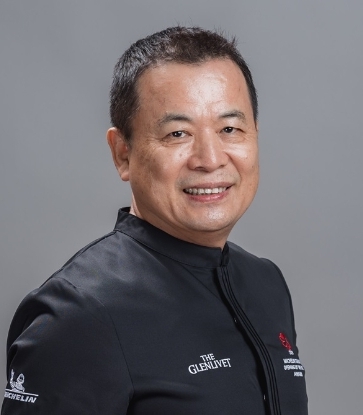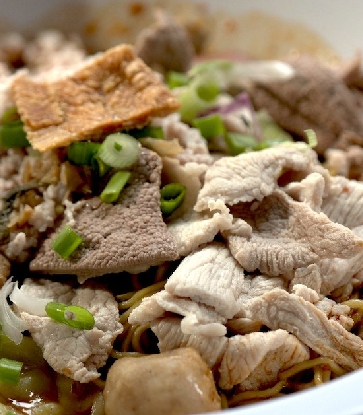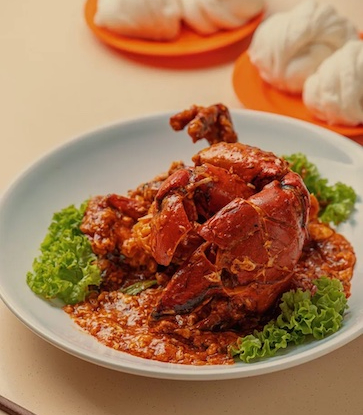In 2023, THOMAS CHIEN was recognised with a Green Star. Chef Thomas Chien has shown commendable commitment to sustainability in various ways: from selection of ingredients and vegetarian options on the menu, to restaurant design and green education initiatives.
We invite him to share his core beliefs and thoughts on the importance of sustainability, as well as how he has built upon these principles to develop the five “green action plan”. Going beyond the creation of gourmet delights, Chien puts into practice initiatives that have a positive impact towards a sustainable future.
RELATED: What is a MICHELIN Green Star?

1. Establish a Green Supply Chain
Since the early days of THOMAS CHIEN, Chien has been using local Taiwanese ingredients for his dishes, such as lettuce and herbs from the farm of Lin Yanting, fondly known as the “Queen of Lettues” .
Later, Chien attended a Slow Food expo in Italy. After returning to Taiwan, the thought that “others have already put this in action, what are we waiting for?” arose in his mind, urging him down the path of using “land-friendly ingredients”. Initially, he sought the assistance of friend to connect him with small farms to arrange visits. Later, he began visiting them himself.
“I needed to know what land-friendly practices the farms have implemented and how to reduce carbon footprint from their farms to my restaurant. When I need specific ingredients, I place orders with these trusted small farms. This way, we can establish a close relationship with the suppliers.”
RELATED: How Taipei's MICHELIN Green Starred Restaurants Combine Sustainability and Gastronomy

He gradually established rules for selecting ingredients: first, he looks for land-friendly ingredients (not necessarily organic), then considers the location of the farm. Higher priority is given to those closer to the restaurant. Of course, quality always comes first.
Taking duck meat as an example, “I start by finding the right land-friendly suppliers. At the beginning I often used Hoyeh ducks from Yilan, but later, I discovered a duck slaughterhouse in Pingtung, so we began searching for suppliers that were located towards the central and southern regions. We found that both central and southern regions have duck meat with very good quality,” he shares.
2. Dedicated to Reducing Surplus Food Ingredients and Food Waste
Chien has always been the frontline purchaser of ingredients. “By personally doing the groceries, I know which ingredients are in abundance and which ones have an excessive supply, and what to know with this information.”
For instance, pumpkins are in season in winter. When there’s an excessive supply, the farmers would use them for compost if no one buys them. Chien started purchasing 3,000-4,000 tkg (approx. 1,800-2,400 kg) of pumpkins every year. With the assistance from the government of the frozen storage space, the restaurant is able to utilize this excellent ingredient throughout the year.

Another example is when there was a surplus in the production of Yuherbau lychees in Kaohsiung’s Dashu District, the Kaohsiung Agriculture Bureau sought Chien's help. He had a thought: Taiwan usually imports lychee puree from France, but now that Taiwan itself has high-quality raw ingredients, why waste them? “So I discussed with them on whether we could find a processing factory to peel and puree these Yuherbau lychees. I could then use them in the restaurant and bakery to make Yuherbau lychee toast and ice cream.”
Chien shares another example: he has started collecting leftover bread from his F&B establishments and donating them to food banks for vulnerable members of society to ensure that the food didn’t go to waste. “In the early days, restaurants and bakeries would discard any leftover bread. I think that’s really wasteful.”
RELATED: Food for Good: MICHELIN Restaurant Chefs Dishing Out Good Food for a Good Cause

3. Adjust the Proportion of Vegetables and Vegetarian Dishes on the Menu
The seed for THOMAS CHIEN’s vegetarian menu was planted during Chien’s 2013 collaboration with Alain Passard, the mastermind behind the MICHELIN Green Star and three-starred restaurant Arpège. “I brought my team to his restaurant for hands-on training to see how he managed his own farm and crushed leftover vegetables and used them to make broth, while the vegetable scraps were used for composting. The concept and his execution of circular utilization of the whole ingredient are really impressive.”
He then became aware of the imbalance in “meat conversion rate” from vegetables to meat: after feeding chickens with 2kg of plant-based feed, only half of that weight is converted into meat. Chien believes that by consuming less meat, there will be less demand for meat, resulting in more utilization of the plants that are not used as animal feed. What’s more, it goes without saying that consuming more vegetables is beneficial to the body.
So he started purposely reducing the amount of meat and increasing the proportion of vegetables in the dishes on his menu. In 2022, he even launched a meatless menu on Earth Day.
In addition, Chien has set up a 99-square-foot herb garden in the restaurant’s outdoor space, where food waste from the restaurant is used as natural compost. “We first dig holes then fill it with layers of food scraps and corrugated boards, then cover them with soil. This allows natural fermentation to take place and turn into nutrients. We then grow our own herbs with it.”
RELATED: The Best Vegetarian-friendly Restaurants in Taipei and Taichung

4. Restaurant Renovation with Full Use of Green Building Materials
In recent years, Chien has chosen to renovate his restaurant using green materials, taking another step towards his blueprint of sustainability.
They collaborated with TaG Living, a design firm that shares the same green philosophy. The renovation used 72% recycled building materials, including hand-crafted walls made from LOTOS, a recycled material made from Penghu oyster shells being ground into powder then mixed with reservoir sludge. The current tabletops and counter surfaces at THOMAS CHIEN are made from a carbon-neutral material crafted from a combination of Penghu oyster shells, steel slags and lime to replace concrete, which has high carbon emissions.
Apart from construction materials, the restaurant also strives to use soft furnishings that are reusable and made from low-waste materials. For example, the carpet is made from recycled fishing nets; the light fixtures are handcrafted with lights embedded in coral stone and adorned with branches and decorative paper; fresh flowers on the tables have been replaced with preserved flowers; and the tabletops are made of engineered marble instead of the traditional white tablecloth commonly used in French restaurants with the goal to reduce resource consumption from having to do frequent laundry.
Taking a different approach, the restaurant aims to strike a balance between showing hospitality to customers and doing good for the planet.
Chien mentions that the overall cost of the restaurant’s renovation was almost 12 million TWD, which is relatively high. Many people asked him why he was willing to spend this much. “I believe that if it’s the right thing to do and you don’t do it, you’ll just be stuck at the same place. If you do it, this may inspire others to follow suit. This is good for the environment and for the Earth. Then it must be done.”
RELATED: Sustainable Dishes from MICHELIN Green Star Restaurants in Asia

5. Green Education
Although Chien believes that the education of sustainability should be left to professionals, he doesn’t hesitate to put it into action by connecting people and resources around him to make an impact.
Every year over the past decade, he has been invited to National Kaohsiung University of Hospitality and Tourism to engage in culinary exchanges with the younger generation of chefs on campus. Sometimes he simply delivers lectures, while other times he conducts cooking demonstrations or even brings along guest chefs like Alain Passard from aboard to the campus. During these lessons, he also shares his green practices and journey at THOMAS CHIEN.
He has shifted his focus towards promoting slow food in the past few years. Upon the invitation of his good friend, he frequently visits Taitung to meet with locals from the F&B industry. “Starting with me, we began to form an organization where we unite and promote together,” he says passionately. “By establishing an awareness of the green industry, consumers will pay more attention to whether the source of ingredients is environmentally friendly, so as to avoid food scarcity and safety issues.”

Think Green, Live Green
On his path to sustainability, the driving force behind Chien’s persistence lies in his belief in the power of continuous improvement.
For seven consecutive years since founding his namesake restaurant in 2012, Chien been inviting top chefs from MICHELIN-starred restaurants in Europe to Taiwan for collaboration that have left important marks on Taiwan’s fine dining history.
When asked why he is willing to invest so much in these collaborations, he explains that it stems from his gratitude towards Pasadena restaurant group’s chairman and his wife, who generously provided him the opportunities to be an apprentice at top-notch restaurants overseas while he served as the culinary director of the group. Now, he wishes to extend this kind gesture and foster an environment where his colleagues can continue to grow.
This article is written in Chinese by Chelsea Su and translated by Iris Wong.
Hero image by Thomas Chien.
RELATED: MICHELIN-Recommended Eats Along the Kaohsiung Metro Line




















